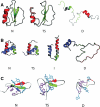Protein folds and protein folding
- PMID: 21051320
- PMCID: PMC3003448
- DOI: 10.1093/protein/gzq096
Protein folds and protein folding
Abstract
The classification of protein folds is necessarily based on the structural elements that distinguish domains. Classification of protein domains consists of two problems: the partition of structures into domains and the classification of domains into sets of similar structures (or folds). Although similar topologies may arise by convergent evolution, the similarity of their respective folding pathways is unknown. The discovery and the characterization of the majority of protein folds will be followed by a similar enumeration of available protein folding pathways. Consequently, understanding the intricacies of structural domains is necessary to understanding their collective folding pathways. We review the current state of the art in the field of protein domain classification and discuss methods for the systematic and comprehensive study of protein folding across protein fold space via atomistic molecular dynamics simulation. Finally, we discuss our large-scale Dynameomics project, which includes simulations of representatives of all autonomous protein folds.
Figures





References
Publication types
MeSH terms
Substances
Grants and funding
LinkOut - more resources
Full Text Sources

